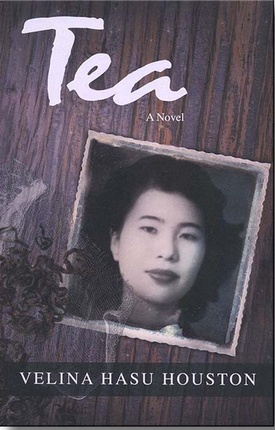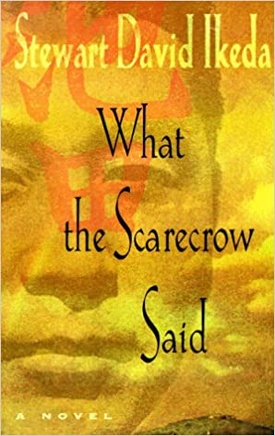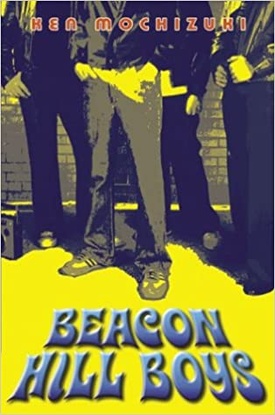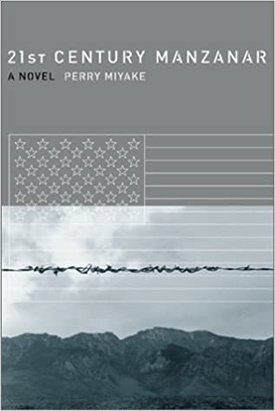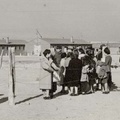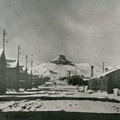For the next twenty years, there was little in the way of Japanese American literature that included any mention of African Americans, even as more Japanese American writers began to be published. One notable exception comes in a trilogy of plays by Velina Hasu Houston that follow the lives of Creed and Setsuko Banks. Asa Ga Kimashita (Morning Has Broken) (1981), the first play in the series, is set in Ehime, Japan in 1945–46. It follows the Shimada family, whose members struggle to adapt to the new realities of a defeated Japan and American occupation. The budding romance between Setsuko, the youngest Shimada daughter, and Creed, an African American GI, brings these issues to the forefront. American Dreams (1985) follows the couple to New York City, while Tea (1987) takes place in Kansas after Creed's death. The three plays are based on Houston's own family story as the daughter of a Japanese mother and African American father. Several of Houston's other plays also include African American or Afro-Japanese characters.
Philip Kan Gotanda's 1999 play Yohen also has as its center a Japanese war bride married to an African American GI. It examines the couple's relationship after some thirty years of marriage. It should be mentioned that the ethnic Korean author Soon-Tek Oh’s groundbreaking 1970 play Tondemonai…Never Happen! which takes place among Japanese Americans and dramatizes wartime incarceration, also features a Japanese war bride married to an African American GI, though her husband is never shown.
In 1988 Gene Oishi, a journalist best known for his work with the Baltimore Sun, published a memoir entitled In Search of Hiroshi with Kodansha Books. Oishi's memoir bears some similarity with the earlier books by Miyamoto and Shirota in that the Nikkei protagonist finds himself thrust into an unfamiliar new world that includes African Americans. In Oishi's case, however, it is in the army, where he is stationed in France in the 1950s.
Unlike the characters in the earlier books, Oishi has an advantage in navigating his new world: he is a musician with some talent for playing jazz. Because of this skill, he ends up playing in jazz bands in which many of his fellow musicians, as well as the club audiences they play for, are African American. His non-white and non-black racial status make him something of a racial mystery. There is also soon a love interest, an African American woman named Yvonne, who is estranged from her soldier husband. The couple's relationship is frowned upon by those surrounding them, with first the jazz club manager taking Oishi aside and telling him he should end it, then with a group of African American soldiers physically preventing him from dancing with her. They subsequently break up. "I decided to hell with her and to hell with black culture," he wrote.
Twenty-six years later, in 2014, Oishi published an autobiographical novel, entitled Fox Drum Bebop, that depicts the same time period. Once again, his protagonist finds himself in the army in France, playing in jazz bands for largely African American audiences, and once again there is a love interest. But this time, the love interest becomes a white prostitute named Suzanne.
In both books, Oishi writes about the white prostitutes who frequented the black clubs and who saw only a black clientele. It was understood by the prostitutes and their customers that they were not to see white clients; if they did, they would no longer be welcomed in the black clubs. In his memoir, Oishi writes that he decided not to approach these women, given his ambiguous racial status.
In the novel, Suzanne is described as the "girl" of his friend Muncey, a black trombonist from Harlem. But when a white soldier takes up with her, Muncey attacks and seriously injures him and is subsequently kicked out of the army. Oishi's alter ego subsequently decides to pursue the lonely Suzanne, though she ultimately rejects him. Paradoxically, the pursuit of a white woman in the novel could be read as Oishi identifying more strongly with African Americans than in his memoir, where he pursued an African American woman.
A final book that includes such "new world" encounters is Stuart David Ikeda's What the Scarecrow Said (1996). Ikeda's protagonist is a middle-aged Nisei widower named William Fujita, and his new world is an almost entirely white New England Quaker town in which he has resettled in 1944–45, having experienced great personal tragedy while incarcerated at the Gila River, Arizona, concentration camp. There are two relatively minor characters who are African American. Jim Little is a WRA staffer at Gila who is also an amateur boxer, and who trains the son of the protagonist. Described as "a friendly, mild-mannered giant," he is treated as just a gopher by the WRA. Fujita's initial reaction to Jim is stereotypical, but he "soon… came to know and become very fond of the giant he'd mistaken for a guard." Little is also a singer and "could talk hepster as if he taught Cab Calloway himself, and he could cuss like nobody's business."
Later in the book, while visiting Philadelphia to see his grandchild, Fujita meets Moses, whom he befriends. Their conversations touch on race, with Moses noting commonalities between Asian Americans and African Americans and telling Fujita that "you'll have to decide if you're black or you're white." Both characters—the gentle giant and the wise old man—feel a bit stereotypical and don't serve much of a function in the book other than to illustrate Fujita's tolerance.
While some Japanese Americans leaving the American concentration camps found themselves in small predominantly white communities like Fujita, many others settled in large cities, whether in the East or Midwest, or back on the West Coast. In many of these cities, they lived alongside African Americans, as housing restrictions forced "minorities" to settle only in certain parts of these cities. Many younger Nisei and Sansei who came of age after the war grew up alongside African Americans.
Daniel I. Okimoto, in his 1971 memoir American in Disguise, describes himself as having “lived among blacks” in the postwar years, and thereby is able to sympathize in later years with the emotional fury of militants within black communities. While Okimoto does not present any individual black characters, he hints at his interactions with them: “Our Negro friends were always a bit astonished to see us eating raw tuna, dried seaweed, raw eggs, and fermented soy beans—and not with forks and spoons but with chopsticks.”
Starting in the mid-1990s, one can begin to see literary works by Sansei that cover the postwar years. While set mostly in Japanese American communities, these novels—and the many plays, novels, and memoirs that followed—organically integrate a variety of African American characters who are friends and enemies, rich and poor, fighters and lovers. Although this trend continues into recent years, for the purposes of this essay, we will discuss only those published up to 2002.
Probably the first of these works to see print was a children's picture book, Sheila Hamanaka's Be-Bop-a-Do-Walk! (1995). Set in postwar New York City, the story follows Japanese American Emi and her best friend Martha, who is African American, as they accompany Emi's father on his errands that take them across town to Central Park. Along the way, they meet a multicultural cast of characters, before making a new friend at the park. The world of the book is a hopeful and idyllic one, where people of all races, ages, and classes happily get along. Based on the author's childhood memories, the book is dedicated to "Ham" Hamanaka, the author's father, who eventually settled in New York after having been incarcerated in Jerome and who became a professional actor under the stage name Conrad Yama.
Two further such books, which themselves anticipated many later similar works, were published in 2002–03. Ken Mochizuki's Beacon Hill Boys (2002) is an autobiographical coming-of-age novel for young adults set in Seattle in 1972, and centers on Sansei protagonist Dan Inagaki, a junior at the fictional Hoover High (based on Cleveland High, the author's alma mater). In contrast, Perry Miyake's 21st Century Manzanar (2002) is a sort-of science fiction novel that imagines another mass removal and incarceration of Japanese Americans in the 21st century. It is set in the Venice/Culver Japanese American community in West Los Angeles, another area where Japanese Americans and African Americans lived near each other.
The world of Hoover High School depicted in Beacon Hill Boys is one where the student body is more less equally divided between African American, white, and Nikkei students. Something of a long-haired misfit in a seemingly perfect Nisei/Sansei family as the book begins, Dan journeys through his junior year, and ultimately finds himself questioning his and other Japanese American families’ fixation on economic status, and leading a push for ethnic studies on campus. Though most of his friends are also Sansei, there are three African American students who play significant roles in his journey. Davie Miles is a football player who is also pursuing Janet Ishino, whom Dan has a crush on.
When a young teacher talks about the Japanese American incarceration in social studies class, Greg Moore, who "resembled Nat King Cole, dressed like James Brown, and talked like H. Rap Brown," says that "I think we were right in movin' 'em all out. They could've been a bunch of spies." Though Dan protests, none of the other Asian American students say anything. The only other person to confront Greg is another African American student, Rhonda Du Bois, who later joins Dan in his efforts to bring more books on ethnic American history into the school library, and who clearly also likes Dan as more than a friend.
Other than Dan's brother's girlfriend, there are no white students who play major roles in the story, suggesting that the white students kept to themselves, while the Sansei and African American students intermingled. But there are also clues as to Nikkei racism towards African Americans. Not only is Davie is never invited over to any Nikkei homes, but there is a consensus among the Japanese Americans that Janet would only be able to accept Davie's prom invitation on the sly, since her parents wouldn't allow it otherwise. Dan also realizes that he has been stereotyping Davie after he visits Davie’s home and is surprised to find that Davie lives in a home just like his, and that his elegantly dressed mother is more attentive and doting towards the boys than any of the Nisei mothers.
One of the core characters in the apocalyptic work of 21st Century Manzanar is Greg Wiley, the close friend of protagonist David Takeda's brother John. After John is beaten to death by thugs early in the novel, Greg visits David and ends up being part of a small group of friends who drive with him to Manzanar to report for the "ReVac." For his troubles, Greg is shot and imprisoned. Later in the book, Greg is part of the multiethnic group that returns to Manzanar to help David escape. Portrayed as loyal and brave—if also hot tempered and impulsive, Greg shares with the Takedas the "Venice mumble," the speech cadence unique to those who grew up in Venice in that time period that make their voices indistinguishable—and indecipherable—to outsiders.
The year 2003 brought the publication of Nina Revoyr's Southland, a favorite of both of ours and one that continues the trend of books set in postwar communities in which both Japanese Americans and African Americans lived. In a future continuation of this essay, Brian will discuss Southland and the many other books of this type written since. There are also some fascinating genre books as well as some works that insert African Americans into the Japanese American World War II incarceration story to decidedly mixed effect.
As we have seen, depictions of African Americans have been a part of English-language Japanese American literature from its beginnings and such depictions have continued throughout as part of the ebb and flow of Japanese American literature in general. These literary works have reflected the changing relationships between Japanese Americans and African Americans over time, even as historical works have, until recent decades, largely ignored these relationships. As we have seen, in examining these works we can learn much about Nikkei's feelings, fantasies and fears about African Americans.
© 2022 Greg Robinson, Brian Niiya



